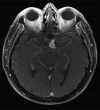Glioblastoma multiforme of the optic chiasm: A rare case of common pathology
- PMID: 27512611
- PMCID: PMC4960928
- DOI: 10.4103/2152-7806.185783
Glioblastoma multiforme of the optic chiasm: A rare case of common pathology
Abstract
Background: Malignant optic and chiasmatic gliomas are extremely rare, and are classified pathologically as anaplastic astrocytoma or glioblastoma multiforme (GBM). Approximately 40 cases of optic GBM in adults have been reported in the literature, and only five of them were described to originate from the optic chiasm.
Case description: An 82-year-old male patient with a past medical history of diabetes mellitus type 2, melanoma, and bladder cancer presented with gradual vision loss of the left eye in a period of 1 month. After neuro-ophthalmological examination, the decision of thither magnetic resonance imaging (MRI) studies was made. It showed a contrast enhancing mass in the region of the optic chiasm. In this case, imaging study was not enough to establish an accurate diagnosis and a left pterional craniotomy for biopsy and resection of the optic chiasmal mass was performed. After histological evaluation of the mass tissue, the diagnosis of GBM was made. Taking into account the patient's poor condition and unfavorable prognosis he was moved to inpatient hospice. The patient deceased within 2 months after surgery.
Conclusion: Chiasmal GBM is an extremely rare condition where a biopsy is necessary for accurate diagnosis and optimal treatment. Differential diagnosis for such lesions can be very difficult and include demyelinating optic neuritis and non-demyelinating inflammatory optic neuropathy (e.g., sarcoid), vascular lesions (e.g., cavernoma), compressive lesions of the optic apparatus, metastatic malignancy, and primary tumors of the anterior optic pathway. The role of chemotherapy and radiotherapy including novel stereotaxic radiosurgery methods is still unclear and will need to be evaluated.
Keywords: Brain tumor; glioblastoma; glioma.
Figures


Similar articles
-
Unilateral malignant optic glioma following glioblastoma multiforme in the young: a case report and literature review.BMC Ophthalmol. 2017 Mar 11;17(1):21. doi: 10.1186/s12886-017-0415-5. BMC Ophthalmol. 2017. PMID: 28284199 Free PMC article.
-
Unilateral adult malignant optic nerve glioma.Graefes Arch Clin Exp Ophthalmol. 2004 Sep;242(9):741-8. doi: 10.1007/s00417-004-0905-z. Graefes Arch Clin Exp Ophthalmol. 2004. PMID: 15085353 Review.
-
Malignant optic glioma presenting as an acute anterior optic neuropathy.Retin Cases Brief Rep. 2009 Spring;3(2):156-60. doi: 10.1097/ICB.0b013e31815f3c95. Retin Cases Brief Rep. 2009. PMID: 25391062
-
Cavernous Hemangioma of the Chiasm and Left Optic Nerve.Cureus. 2020 May 12;12(5):e8068. doi: 10.7759/cureus.8068. Cureus. 2020. PMID: 32420001 Free PMC article.
-
Optic Nerve Glioblastoma with Optic Chiasm Involvement: A Case Report and a Brief Literature Review.Medicina (Kaunas). 2024 Oct 14;60(10):1687. doi: 10.3390/medicina60101687. Medicina (Kaunas). 2024. PMID: 39459474 Free PMC article. Review.
Cited by
-
Magnetic resonance imaging characteristics of glioblastoma of the optic pathway during adulthood.Radiol Case Rep. 2023 May 26;18(8):2628-2632. doi: 10.1016/j.radcr.2023.05.010. eCollection 2023 Aug. Radiol Case Rep. 2023. PMID: 37273722 Free PMC article.
-
Primary glioblastoma multiform (GBM) of the optic nerve and chiasma: A case report and systematic review of the literature.Clin Case Rep. 2024 Mar 20;12(3):e8636. doi: 10.1002/ccr3.8636. eCollection 2024 Mar. Clin Case Rep. 2024. PMID: 38515994 Free PMC article.
-
Multicentric Glioblastoma Multiforme Mimicking Optic Neuritis.Neuroophthalmology. 2017 Aug 2;42(2):112-116. doi: 10.1080/01658107.2017.1350194. eCollection 2018 Apr. Neuroophthalmology. 2017. PMID: 29563957 Free PMC article.
References
-
- Alvord EC, Jr, Lofton S. Gliomas of the optic nerve or chiasm. Outcome by patients’ age, tumor site, and treatment. J Neurosurg. 1988;68:85–98. - PubMed
-
- Ashur-Fabian O, Blumenthal DT, Bakon M, Nass D, Davis PJ, Hercbergs A. Long-term response in high-grade optic glioma treated with medically induced hypothyroidism and carboplatin: A case report and review of the literature. Anticancer Drugs. 2013;24:315–23. - PubMed
-
- Caignard A, Faguer R, Mercier P, Menei P, Milea D. Optic nerve and visual pathways primary glioblastoma treated with radiotherapy and temozolomide chemotherapy. Eur J Ophthalmol. 2014;24:637–40. - PubMed
-
- Darefsky AS, Dubrow R. International variation in the incidence of adult primary malignant neoplasms of the brain and central nervous system. Cancer Causes Control. 2009;20:1593–1604. - PubMed
LinkOut - more resources
Full Text Sources
Other Literature Sources
Miscellaneous

